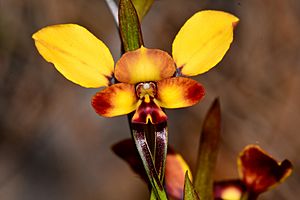Small-flowered donkey orchid facts for kids
Quick facts for kids Small-flowered donkey orchid |
|
|---|---|
 |
|
| Diuris porrifolia growing in Wandoo National Park | |
| Scientific classification | |
| Genus: |
Diuris
|
| Species: |
porrifolia
|
| Synonyms | |
The Diuris porrifolia, also known as the small-flowered donkey orchid, is a special type of orchid. It grows only in the south-west part of Western Australia. This means it is endemic to that area. This orchid has two or three leaves and can grow up to seven yellow flowers. These flowers often have brown or reddish marks on them.
This orchid looks a bit like the common donkey orchid (D. corymbosa). However, its flowers are smaller. It also tends to grow more towards the eastern parts of Western Australia.
Contents
What Does the Small-Flowered Donkey Orchid Look Like?
The Diuris porrifolia is a plant that grows from a tuber (a kind of underground stem). It lives for many years, so it's a perennial herb. It usually has two or three leaves. These leaves are about 100 to 200 mm (4-8 inches) long and 8 to 13 mm (0.3-0.5 inches) wide.
The plant can have up to seven yellow flowers. These flowers have brown or reddish markings. Each flower is about 18 to 25 mm (0.7-1 inch) long and wide. The flowering stem, which holds the flowers, can be 150 to 350 mm (6-14 inches) tall.
Flower Parts Explained
Let's look at the parts of the flower:
- The dorsal sepal (the top part) stands straight up. It is about 7 to 10 mm (0.3-0.4 inches) long and 8 to 10 mm (0.3-0.4 inches) wide.
- The lateral sepals (the side parts) point downwards. They are about 15 to 19 mm (0.6-0.7 inches) long and about 3 mm (0.1 inches) wide.
- The petals stand mostly upright. They are 10 to 13 mm (0.4-0.5 inches) long and 5 to 7 mm (0.2-0.3 inches) wide. Each petal sits on a small stalk about 4 to 6 mm (0.16-0.24 inches) long.
- The labellum (the lip of the flower) has a middle part that is shaped like a wedge. It has a fold in the middle. This part is about 5 to 6 mm (0.2-0.24 inches) long and 4.5 mm (0.18 inches) wide. The side parts of the labellum are 6 to 8 mm (0.2-0.3 inches) long and 3 to 4 mm (0.1-0.2 inches) wide.
This orchid blooms from late July to September.
How is it Different from Similar Orchids?
The small-flowered donkey orchid is similar to the common donkey orchid (D. corymbosa). But, D. porrifolia has smaller flowers. It also grows more to the east.
It has also been confused with another orchid called the western wheatbelt donkey orchid (D. brachyscapa). This orchid was only officially named in 2016. D. brachyscapa has larger flowers and grows more to the west.
History and Naming of the Orchid
The Diuris porrifolia was first officially described in 1840. A botanist named John Lindley wrote about it. His description was published in a book called A Sketch of the Vegetation of the Swan River Colony. This book was an extra part of Edwards's Botanical Register.
The name porrifolia comes from two Latin words. Porrum means "a leek" and folia means "leaves". So, the name refers to how the leaves of this orchid look, similar to a leek.
Some older plant lists, like the Index Kewensis, used to list Diuris porrifolia as the same as Diuris corymbosa. However, they are now recognized as different species.
Where Does the Small-Flowered Donkey Orchid Live?
You can find the small-flowered donkey orchid growing between the cities of Perth and Boyup Brook. It likes to grow in areas with woodland and forest.
Is This Orchid Safe?
The Western Australian Government's Department of Parks and Wildlife says that Diuris porrifolia is "not threatened". This means it is not currently in danger of disappearing.
Images for kids


